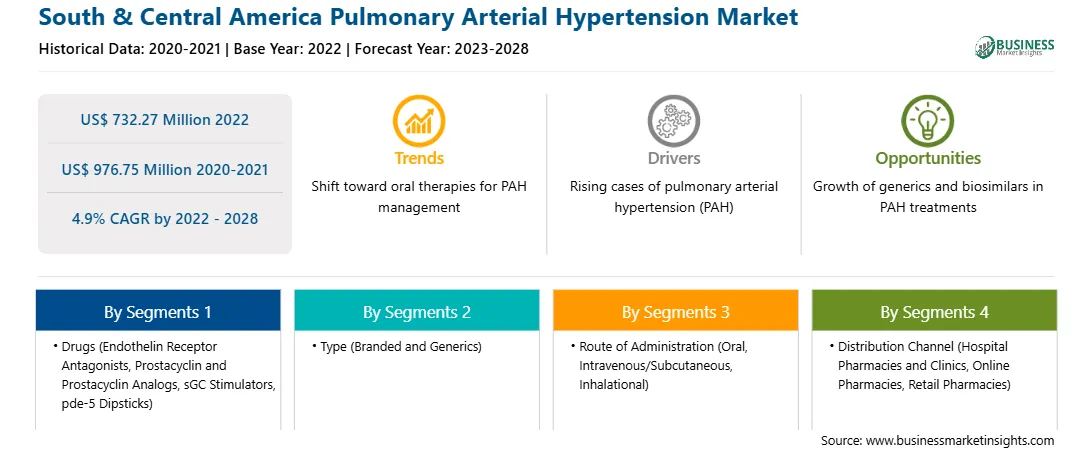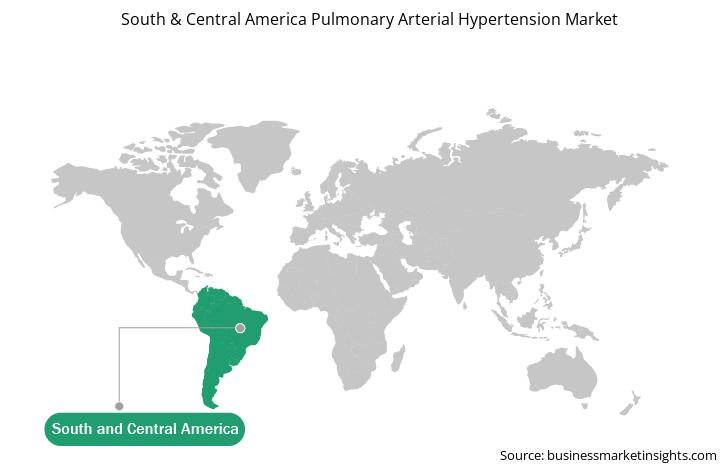Growing Patent Expiration to Offer Lucrative Opportunities for South & Central America Pulmonary Arterial Hypertension Market Growth During Forecast Period
Patent expiry permits generic drugs to enter the market and diversify product offerings. A few patented products are expected to become off-patent in the coming years, which is likely to provide an enormous opportunity for generic formulation companies. Many pharma companies such as finds Care Ratings are already working to develop the generic version of patented products. After patent expiration, generic versions of drugs can become available. While consumers benefit from low prices, losing patent protection can expose pharmaceutical companies to growing competition. Thus, patent expiration is expected to offer an opportunity for generic drug manufacturers to enter a new market. Hence, the growing patent expiration is expected to offer lucrative opportunities for the South & Central America pulmonary arterial hypertension market growth in the coming years.
South & Central America Pulmonary Arterial Hypertension Market Overview
Pulmonary arterial hypertension (PAH) is a rare, progressive disease. As per a study titled “Pulmonary Arterial Hypertension in Brazil: Treatment Patterns and Hospitalization Based on Primary Research,” published in December 2020, a survey was conducted with six experts in treating PAH in referential public hospitals. Approximately 1,045 patients were treated by the physicians in the 12 months prior to the survey. Treatment patterns and hospitalization were analyzed by patient’s risk stratification. Most physicians (67%) stratified patients by risk. Double therapy was used in 47%, 99%, and 74%, and triple therapy at 0%, 1%, and 26% of the patients in low-risk, intermediate-risk, and high-risk groups, respectively. Healthcare resource utilization was greater in patients with progressed pulmonary arterial hypertension, considering medication or hospitalization needs, indicating that costs were 56% higher. Moreover, schistosomiasis was mentioned as one of the most common subtypes of pulmonary arterial hypertension by the Brazilian registry. Data from referral centers in nonendemic regions indicate that up to 30% of pulmonary arterial hypertension cases may be related to schistosomiasis, with a prevalence of schistosomiasis-associated pulmonary arterial hypertension (Sch-PAH) in 4.6% of PAH patients in the country. According to the study “Basic and associated causes of schistosomiasis-related mortality in Brazil,” published in 2021, ~4,168 schistosomiasis-related deaths were recorded between 1999 and 2018, as patients with PAH in the country face several barriers to treatment. Further, the Sociedade Brasileira de Pneumologia e Tisiologia (SBPT, Brazilian Thoracic Association) Pulmonary Circulation Committee, founded in 1996, has been involved in continued education and development of guidelines/recommendations for the management of pulmonary arterial hypertension and chronic thromboembolic pulmonary hypertension over the years in the country. This committee plans any update on the recommendations for the treatment of pulmonary arterial hypertension in the country. In April 2022, as per an article, the Brazilian defense ministry ordered Viagra pills for troops to treat patients with pulmonary arterial hypertension. In Brazil, PAH‐specific therapies are regulated by a national protocol, formed and published by the Ministry of Health, and funded by the public healthcare system. Currently, few drugs are approved for treating PAH within the Sistema Único de Saúde (SUS, Brazilian Unified Health Care System) in Brazil. The PAH‐specific drugs reimbursed in the country include sildenafil, ambrisentan, and bosentan. Other PAH‐specific drugs, such as selexipag, are approved for usage within the country but are not reimbursed by the national or local government. Thus, as per the above-mentioned factors, the South & Central America pulmonary arterial hypertension market is expected to grow steadily in the country during the forecast period.

Strategic insights for the South & Central America Pulmonary Arterial Hypertension provides data-driven analysis of the industry landscape, including current trends, key players, and regional nuances. These insights offer actionable recommendations, enabling readers to differentiate themselves from competitors by identifying untapped segments or developing unique value propositions. Leveraging data analytics, these insights help industry players anticipate the market shifts, whether investors, manufacturers, or other stakeholders. A future-oriented perspective is essential, helping stakeholders anticipate market shifts and position themselves for long-term success in this dynamic region. Ultimately, effective strategic insights empower readers to make informed decisions that drive profitability and achieve their business objectives within the market.

| Report Attribute | Details |
|---|---|
| Market size in 2022 | US$ 732.27 Million |
| Market Size by 2028 | US$ 976.75 Million |
| Global CAGR (2022 - 2028) | 4.9% |
| Historical Data | 2020-2021 |
| Forecast period | 2023-2028 |
| Segments Covered |
By Drugs
|
| Regions and Countries Covered | South and Central America
|
| Market leaders and key company profiles |
The geographic scope of the South & Central America Pulmonary Arterial Hypertension refers to the specific areas in which a business operates and competes. Understanding local distinctions, such as diverse consumer preferences (e.g., demand for specific plug types or battery backup durations), varying economic conditions, and regulatory environments, is crucial for tailoring strategies to specific markets. Businesses can expand their reach by identifying underserved areas or adapting their offerings to meet local demands. A clear market focus allows for more effective resource allocation, targeted marketing campaigns, and better positioning against local competitors, ultimately driving growth in those targeted areas.

South & Central America Pulmonary Arterial Hypertension Market Segmentation
The South & Central America pulmonary arterial hypertension market is segmented on the basis of drugs, type, route of administration, distribution channel, and country.
Based on drugs, the South & Central America pulmonary arterial hypertension market is segmented into endothelin receptor antagonists (ERAs), prostacyclin and prostacyclin analogs, sGC stimulators, and pde-5 dipsticks. In 2022, the prostacyclin and prostacyclin analogs segment registered the largest share in the South & Central America pulmonary arterial hypertension market.
Based on type, the South & Central America pulmonary arterial hypertension market is bifurcated into branded and generics. In 2022, the branded segment registered a larger share in the South & Central America pulmonary arterial hypertension market.
Based on route of administration, the South & Central America pulmonary arterial hypertension market is segmented into oral, intravenous/subcutaneous, and inhalational. In 2022, the oral segment registered the largest share in the South & Central America pulmonary arterial hypertension market.
Based on distribution channel, the South & Central America pulmonary arterial hypertension market is segmented into hospital pharmacies and clinics, online pharmacies, and retail pharmacies. In 2022, the hospital pharmacies and clinics segment registered the largest share in the South & Central America pulmonary arterial hypertension market.
Based on country, the South & Central America pulmonary arterial hypertension market is segmented into Brazil, Argentina, and the Rest of South & Central America. In 2022, Brazil registered the largest share in the South & Central America pulmonary arterial hypertension market.
Bayer AG, Gilead Sciences Inc, GSK Plc, Johnson & Johnson, Lupin Ltd, Novartis AG, Pfizer Inc, and Teva Pharmaceutical Industries Ltd are the leading companies operating in the South & Central America pulmonary arterial hypertension market.
The South & Central America Pulmonary Arterial Hypertension Market is valued at US$ 732.27 Million in 2022, it is projected to reach US$ 976.75 Million by 2028.
As per our report South & Central America Pulmonary Arterial Hypertension Market, the market size is valued at US$ 732.27 Million in 2022, projecting it to reach US$ 976.75 Million by 2028. This translates to a CAGR of approximately 4.9% during the forecast period.
The South & Central America Pulmonary Arterial Hypertension Market report typically cover these key segments-
The historic period, base year, and forecast period can vary slightly depending on the specific market research report. However, for the South & Central America Pulmonary Arterial Hypertension Market report:
The South & Central America Pulmonary Arterial Hypertension Market is populated by several key players, each contributing to its growth and innovation. Some of the major players include:
The South & Central America Pulmonary Arterial Hypertension Market report is valuable for diverse stakeholders, including:
Essentially, anyone involved in or considering involvement in the South & Central America Pulmonary Arterial Hypertension Market value chain can benefit from the information contained in a comprehensive market report.